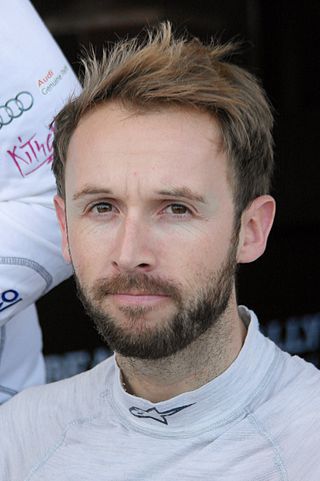A Formula One car or F1 car is a single-seat, open-cockpit, open-wheel formula racing car with substantial front and rear wings, and an engine positioned behind the driver, intended to be used in competition at Formula One racing events. The regulations governing the cars are unique to the championship and specify that cars must be constructed by the racing teams themselves, though the design and manufacture can be outsourced. Formula One drivers experience peak cornering forces of up to six lateral g.
The Japanese Super Formula Championship is a formula racing series held primarily in Japan. It is considered to be the pinnacle of single-seater racing in Japan or Asia as a whole, making it one of the top motorsport series in the region. The series is sanctioned by the Japan Automobile Federation (JAF) and managed by Japan Race Promotion (JRP). As of 2024, Super Formula is the second fastest racing series in the world, after Formula One.
A1 Grand Prix (A1GP) was a "single-make" open-wheel auto racing series that ran from 2005 until 2009. It was unique in its field in that competitors solely represented their nation as opposed to themselves or a team, the usual format in most formula racing series. As such, it was often promoted as the "World Cup of Motorsport". The series was ratified by the Fédération Internationale de l'Automobile (FIA), and races were held in the traditional Formula One off-season, the northern hemisphere winter. The nation-based A1GP concept was founded by Sheikh Maktoum Hasher Maktoum Al Maktoum of Dubai, initially in 2003. After a successful first season of A1GP, it was announced on 29 September 2006 that Maktoum was to sell his position as chairman and director of A1GP. The transfer of his share in the organisation of A1 Grand Prix to RAB Capital was finalized in December 2006. Tony Teixeira took control of the series in 2006, and the series later liquidated after failing to host any races during the 2009–10 season.

The GP2 Series was a form of open wheel motor racing introduced in 2005 following the discontinuation of the long-term Formula One feeder series, Formula 3000. The GP2 format was conceived by Bernie Ecclestone and Flavio Briatore, while Ecclestone also has the rights to the name GP1. The series was organized by Bruno Michel. In 2010, the GP3 Series class was launched, as a feeder class for the GP2 series. In 2017, the series was rebranded as the FIA Formula 2 Championship.

Indy NXT, previously Indy Lights, is an American developmental automobile racing series sanctioned by IndyCar, currently known as INDY NXT by Firestone for sponsorship reasons. Indy NXT is the highest step on the Road to Indy, a program of racing series leading up to the IndyCar Series.

The Lola A1GP was a vehicle designed to compete in the A1 Grand Prix. The car was standardised for every team to provide a level playing field for competing nations. It was designed to reduce the volume of "dirty air", allowing drivers to close in on the car in front, encouraging overtaking. The bodywork was mainly pre-impregnated carbon fibre composites. From 2008–09 Ferrari was consulted on the design and manufacture for all A1 Grand Prix cars. From the 2008-2009 season the Lola A1GP car was replaced by the A1GP Powered by Ferrari car.

The IndyCar Series, currently known as the NTT IndyCar Series under sponsorship, is the highest class of American open-wheel car racing in the United States, which has been conducted under the auspices of various sanctioning bodies since 1920 after two initial attempts in 1905 and 1916. The series is self-sanctioned by its parent company, IndyCar, LLC., which began in 1996 as the Indy Racing League (IRL) and was created by then Indianapolis Motor Speedway owner Tony George as a competitor to Championship Auto Racing Teams (CART). In 2008, the IndyCar Series merged with CART's successor, the Champ Car World Series and the history and statistics of both series, as well as those from its predecessors, were unified.
The 2004 Champ Car World Series season was the 26th overall season in the CART/Champ Car genealogy, and the first under the ownership of Open-Wheel Racing Series (OWRS) as the Champ Car World Series. It began on April 18, 2004, and ended on November 7 after 14 races. For sponsorship purposes, it was branded as Bridgestone Presents the Champ Car World Series Powered by Ford. The Drivers' Champion was Sébastien Bourdais. The Rookie of the Year was A. J. Allmendinger.
Superleague Formula was an open wheel single seater motor racing formula, which started in 2008, at Donington Park in the United Kingdom. The league introduced team sponsorship by association football clubs. It used the slogan 'The Beautiful Race: Football at 300 km/h'. By 2011 the link with football was fading with more than half the teams no longer associated with football teams. It was founded by businessmen Alex Andreu and Robin Webb. On 19 May 2010, Andreu stepped down in his role as series president, with Alfredo Brisac named as his successor not many weeks later. The season ran between April and November at the same time as most other European race series. Every team used identical cars and 750-horsepower V-12 engines. The Sonangol Group was the series' title sponsor from June 2009 until the end of the 2010 season.

The Williams FW15C is a Formula One car designed by Adrian Newey and built by Williams Grand Prix Engineering for use in the 1993 Formula One World Championship. It was powered by a Renault V10 engine and driven by Frenchman Alain Prost and Briton Damon Hill.

The FIA Formula Two Championship was a one-make class of auto racing for Formula Two open wheeled single seater racing cars. The championship was contested each year from 2009 to 2012. It was a revival of the former European Formula Two Championship that was previously run from 1967 to 1984. Organised by MotorSport Vision, drivers competed over 16 rounds at eight venues, in identical cars built by Williams Grand Prix Engineering, with 400 bhp engines developed by Mountune Racing and supplied by Audi.
The following is a glossary of terminology used in motorsport, along with explanations of their meanings.

The 2011 Australian Grand Prix was a Formula One motor race held on 27 March 2011 at the Albert Park Circuit in Melbourne. It was the 76th race in the combined history of the Australian Grand Prix that dates back to the 100 Miles Road Race of 1928. Originally planned as the second race of the 2011 Formula One season, it became the season opener with the cancellation of the Bahrain Grand Prix due to civil unrest in the country.

In motor racing, the drag reduction system (DRS) is a form of driver-adjustable bodywork aimed at reducing aerodynamic drag in order to increase top speed and promote overtaking. It is an adjustable rear wing of the car, which moves in response to driver commands. DRS often comes with conditions, such as the requirement in Formula 1 that the pursuing car must be within one second for DRS to be activated.

Formula E, officially the ABB FIA Formula E World Championship, is an open-wheel single-seater motorsport championship for electric cars. The racing series is the highest class of competition for electrically powered single-seater racing cars. The inaugural championship race was held in Beijing in September 2014. Since 2020, the series has FIA world championship status.

The FIA Formula 2 Championship is a second-tier single-seater championship organized by the Fédération Internationale de l'Automobile (FIA). Held on racing circuits, the championship was introduced in 2017, following the rebranding of the long-term Formula One feeder series GP2. The series' original founders were Flavio Briatore and current managing director Bruno Michel.

The 2019 DTM was the thirty-third season of premier German touring car championship, first season under "Class 1" regulations era and also twentieth season under the moniker of DTM since the series' resumption in 2000. Mercedes-AMG withdrew from the championship after the 2018 season to focus on their Formula E entry. British sports car manufacturer Aston Martin replaced Mercedes-Benz, which marked the first non-German entry in 23 years when Italian car manufacturer Alfa Romeo last entered the series under the International Touring Car Series name in 1996. Defending champion Gary Paffett did not return to defend his title, as he moved to Formula E.

The FIA Formula 3 Championship is a third-tier international single-seater racing championship and organised by the Fédération Internationale de l'Automobile (FIA). The championship launched in 2019 as a feeder series for the FIA Formula 1 World Championship and FIA Formula 2 Championships. It was the result of a merger between two third-tier single-seater racing championships, the GP3 Series and the FIA Formula 3 European Championship as it was announced on 10 March 2018. The championship is part of the FIA Global Pathway consolidation project plan. Unlike its predecessor, the Formula 3 European Championship, the series runs exclusively in support of Formula One races.

The 2018 Ad Diriyah ePrix was a Formula E electric car race held at the Riyadh Street Circuit in the town of Diriyah, which is located north-west of the Saudi Arabian capital of Riyadh, on 15 December 2018 before a crowd of about 23,000 spectators. It was the first round of the 2018–19 Formula E Championship, the inaugural Ad Diriyah ePrix and the first Middle Eastern Formula E race.António Félix da Costa of the Andretti team won the 33-lap race from pole position. Techeetah driver Jean-Éric Vergne finished second and Jérôme d'Ambrosio took third for Mahindra.

A1GP Powered by Ferrari car is a vehicle designed to compete in the A1 Grand Prix. The chassis is based on the Formula One Ferrari F2004 chassis. It is made from carbon-fibre skins with an aluminium honeycomb core, and has been tested to meet all FIA crash safety standards. Only 23 cars were ever made.
















